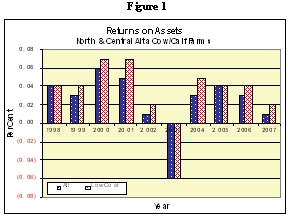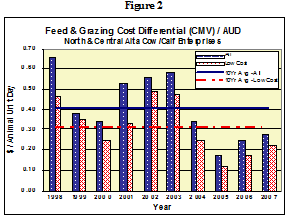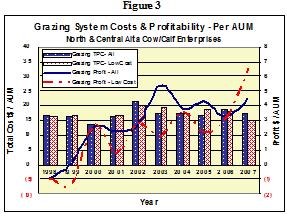| | Economic analysis | Beef operations are profitable | It’s cheaper to graze than feed | The land gets paid too | Home stretch
30-Jan-09
An economic analysis of north and central Alberta beef operations has yielded significant insights regarding the durability of the industry over the past 10 years and opportunities for profit driven change. Key drivers supporting the “economics of change” are farm level financial strengths and potential for herd cost reductions through integrated herd and grazing systems
Economic Analysis
The 10-year analysis of north and central Alberta beef operations involved sifting and sorting hundreds of AgriProfit$ records. Trends in year-to-year farm financial performance and the economics of cow herds and grazing systems were evaluated. To bring further focus, the average of “All” (all participating farms) was contrasted with “Low Cost” (farms with herds in the lower half of total production costs, by year).
As a cautionary note, the analysis relates to averages and trends. There is variation about these averages, meaning there are businesses that performed well and others that did not in any given year.
The analyses indicated opportunities for change in the future, based on solid economic rationale.
Beef Operations Are Profitable
In the past couple of years, even though calf prices and input expenses may have dampened some of the optimism and “go forward” attitude that perennially characterizes the beef industry, north and central Alberta beef farms fared reasonably well. During the period of 1998 – 2007 (Figure 1), farm level return on assets averaged about 3%, with the low cost group averaging 4%. What messages does this deliver?
Clearly, the drought in 2002 and BSE in 2003 substantially reduced the average return on assets. The upside is that these events kick-started a change process in the industry. Producers began to look long and hard at how they were producing. They were driven to fundamentally change their businesses and production systems, taking them to a sustainable, lower cost level.
Keeping the farm level return on assets in the 1 – 4% range over this period suggests that these beef businesses have systematically changed. Subtly, the most important message is that managers have visibly adapted to changing times.

It’s Cheaper To Graze Than Feed
The low cost group led the shift in days feeding to days grazing. This is driven by the notion that providing feed dry matter from grazing sources, at market value, is more cost effective than acquiring and delivering feed in drylot. This trend is also apparent in the “All” group over the 10-year span.
Figure 2 shows the gap, between feed and grazing costs, when each brought into the cow herd at market value. In 1998, the gap between feed cost per Animal Unit Day (AUD) of feeding and grazing cost per AUD of grazing was $0.66 for the overall average and $0.46 for the low cost group. These amounts reflect cost savings to the herd for each AUD of feeding replaced by grazing.
For example, on a 200 cow herd (averaging 1,350 lbs/cow), a 2 week feeding to grazing shift equals a cost savings of $12.50/cow. This is for dry matter costs alone. The costs of time, fuel, equipment, etc. required to do the feeding are yet to be added!

Approaching 2007, the differential dwindled to the $0.20 - $0.30 / AUD range. Observations on both the shift and its final resting place include:
- From 1998 - 02, shifts were incremental, adding grazing days through practices like aftermath grazing and small swath grazing parcels.
- Particularly in the low cost group, as time progressed shifts in grazing systems appeared, with more purposeful combinations of native, perennial and annual grazing options.
- In the latter years both groups revealed lower average herd operating and fixed costs linked generally to adjustments in feeding systems (types of feeds, labour use, machinery required).
While this gap persists, there is opportunity to bring further cost effectiveness to cow herds. Gains made to this point have been mostly via application of production options that were easy to identify and implement. To close this gap further will require on-farm economic assessments of:
- grazing systems available to producers, relevant to their operations and locale
- winter feeding systems that complement the grazing opportunities
- other related production systems, such as types of feed used and calving season
Such assessments will lead to long term, truly integrated systems.
The Land Gets Paid Too
The role of grazing land in the success of north and central Alberta cow/calf operations is easily overlooked. Grazing lands underpinning many cow herds have helped create observed profits at the farm level while the herds within struggled.

Figure 3 highlights the performance of grazing systems integrated within beef operations. These systems are dynamic from an economics perspective. They include a multitude of elements that change within the system, across years, and among farms. Basic observations include:
- Producers often ignore the profit motive for grazing land when used by the cow herd. On the other hand grazing land is often undervalued as a profitable land use compared to field crops.
- Grazing system costs, per Animal Unit Month (AUM), stayed stable. Systems adapted, dealing with pressures of rising input expense, required productivity gains and balancing between intensive vs. extensive options.
- When a realistic market value is applied to grazing production, it is consistently profitable. Given emerging grazing systems thinking and technology options this will continue to improve.
A significant profit opportunity for Alberta cow/calf operators is linked to a systems approach to managing the herd and the grazing resource.
Home Stretch
Over the past 10 years, economics has both driven and led a significant change in the Alberta cow/calf industry. The key elements are:
- On-going, reasonable farm level profitability,
- Feed to grazing days cost gap in cow herds, and
- Profit potential within grazing enterprises, particularly with a “systems” approach
Using economics as a management tool paves the way to sustainable profits, with manageable risk.
Dale A. Kaliel
Sr. Economist: Production Economics
Economics & Competitiveness Division
|
|